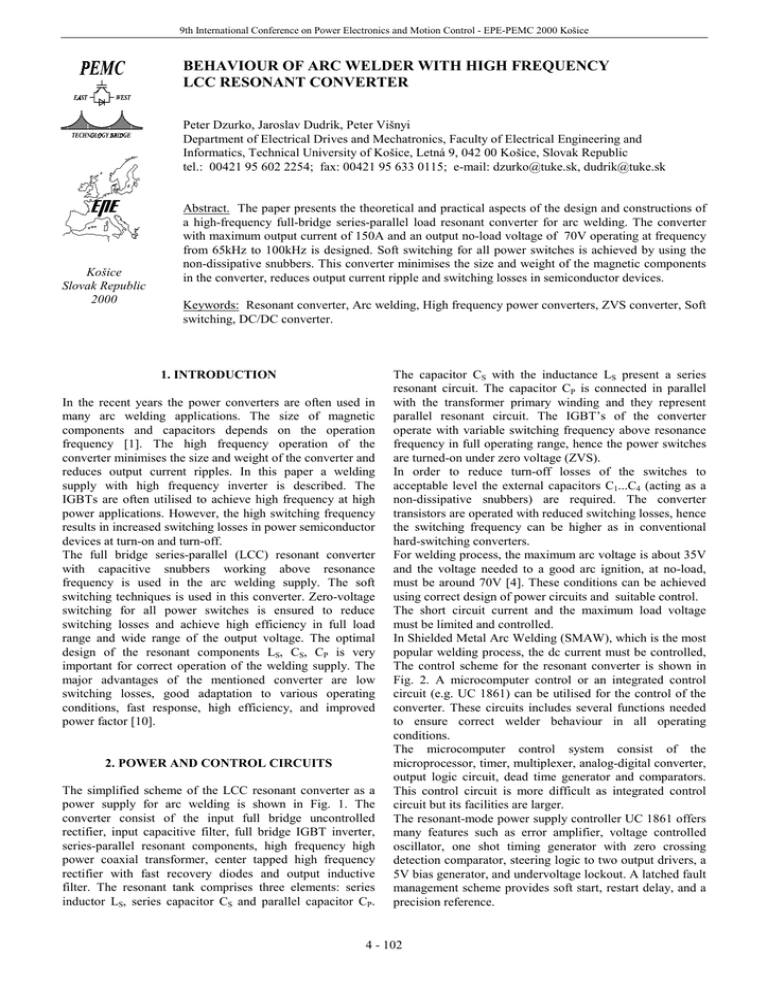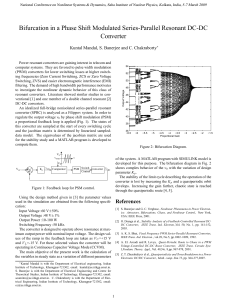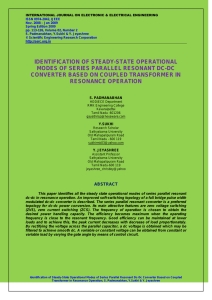behaviour of arc welder with high frequency lcc resonant converter
advertisement

9th International Conference on Power Electronics and Motion Control - EPE-PEMC 2000 Košice BEHAVIOUR OF ARC WELDER WITH HIGH FREQUENCY LCC RESONANT CONVERTER Peter Dzurko, Jaroslav Dudrík, Peter Višnyi Department of Electrical Drives and Mechatronics, Faculty of Electrical Engineering and Informatics, Technical University of Košice, Letná 9, 042 00 Košice, Slovak Republic tel.: 00421 95 602 2254; fax: 00421 95 633 0115; e-mail: dzurko@tuke.sk, dudrik@tuke.sk Košice Slovak Republic 2000 Abstract. The paper presents the theoretical and practical aspects of the design and constructions of a high-frequency full-bridge series-parallel load resonant converter for arc welding. The converter with maximum output current of 150A and an output no-load voltage of 70V operating at frequency from 65kHz to 100kHz is designed. Soft switching for all power switches is achieved by using the non-dissipative snubbers. This converter minimises the size and weight of the magnetic components in the converter, reduces output current ripple and switching losses in semiconductor devices. Keywords: Resonant converter, Arc welding, High frequency power converters, ZVS converter, Soft switching, DC/DC converter. 1. INTRODUCTION In the recent years the power converters are often used in many arc welding applications. The size of magnetic components and capacitors depends on the operation frequency [1]. The high frequency operation of the converter minimises the size and weight of the converter and reduces output current ripples. In this paper a welding supply with high frequency inverter is described. The IGBTs are often utilised to achieve high frequency at high power applications. However, the high switching frequency results in increased switching losses in power semiconductor devices at turn-on and turn-off. The full bridge series-parallel (LCC) resonant converter with capacitive snubbers working above resonance frequency is used in the arc welding supply. The soft switching techniques is used in this converter. Zero-voltage switching for all power switches is ensured to reduce switching losses and achieve high efficiency in full load range and wide range of the output voltage. The optimal design of the resonant components LS, CS, CP is very important for correct operation of the welding supply. The major advantages of the mentioned converter are low switching losses, good adaptation to various operating conditions, fast response, high efficiency, and improved power factor [10]. 2. POWER AND CONTROL CIRCUITS The simplified scheme of the LCC resonant converter as a power supply for arc welding is shown in Fig. 1. The converter consist of the input full bridge uncontrolled rectifier, input capacitive filter, full bridge IGBT inverter, series-parallel resonant components, high frequency high power coaxial transformer, center tapped high frequency rectifier with fast recovery diodes and output inductive filter. The resonant tank comprises three elements: series inductor LS, series capacitor CS and parallel capacitor CP. The capacitor CS with the inductance LS present a series resonant circuit. The capacitor CP is connected in parallel with the transformer primary winding and they represent parallel resonant circuit. The IGBT’s of the converter operate with variable switching frequency above resonance frequency in full operating range, hence the power switches are turned-on under zero voltage (ZVS). In order to reduce turn-off losses of the switches to acceptable level the external capacitors C1...C4 (acting as a non-dissipative snubbers) are required. The converter transistors are operated with reduced switching losses, hence the switching frequency can be higher as in conventional hard-switching converters. For welding process, the maximum arc voltage is about 35V and the voltage needed to a good arc ignition, at no-load, must be around 70V [4]. These conditions can be achieved using correct design of power circuits and suitable control. The short circuit current and the maximum load voltage must be limited and controlled. In Shielded Metal Arc Welding (SMAW), which is the most popular welding process, the dc current must be controlled, The control scheme for the resonant converter is shown in Fig. 2. A microcomputer control or an integrated control circuit (e.g. UC 1861) can be utilised for the control of the converter. These circuits includes several functions needed to ensure correct welder behaviour in all operating conditions. The microcomputer control system consist of the microprocessor, timer, multiplexer, analog-digital converter, output logic circuit, dead time generator and comparators. This control circuit is more difficult as integrated control circuit but its facilities are larger. The resonant-mode power supply controller UC 1861 offers many features such as error amplifier, voltage controlled oscillator, one shot timing generator with zero crossing detection comparator, steering logic to two output drivers, a 5V bias generator, and undervoltage lockout. A latched fault management scheme provides soft start, restart delay, and a precision reference. 4 - 102 9th International Conference on Power Electronics and Motion Control - EPE-PEMC 2000 Košice T1 CP D 1 C1 LS C F1 V IN CS VS T4 T3 C2 T2 iR TR D 4 C4 D5 C3 D 3 D6 D2 LL iO vO RL Fig. 1. Full-bridge series-parallel resonant converter for arc welding The both resonant-mode control circuits are completely galvanically separated from the power circuits. The resonant inverter working above the resonance frequency requires controlled switch-off times to ensure zero-voltage switching. The zero switch voltage needs to be sensed for both switches T1, T4 in the arm and translate through sensing transformers to the zero input of the control circuit VS1, VS2. The output current is sensed by a special current transformer. The rectified voltage from the current transformer CS1 is fed into the non inverting input of the error amplifier as a feedback. The output voltage is sensed by a voltage transformer and the rectified voltage VS5 from transformer is fed into the comparator with hysteresis. If the output voltage vO is greater than the maximum value VOmax the switching frequency is adjusted on the maximum value, thus the minimum value of the output voltage is achieved. The control circuits ensure that the welding process starts with maximum frequency. Regulation is achieved by comparing actual voltage, which is proportional to the output current against reference voltage. Any changes of the output current due to load variations cause the pulse frequency change according to load and line conditions, stabilising the output current. The current transformer CS2 is used by sensing the current in the resonant tank for overcurrent protection of the transistors. The high voltage MOS and IGBT gate drivers SKHI 20 are used to drive IGBTs. 3. DESIGN OF THE CONVERTER The simplified model of the LCC-type series-parallel resonant converter used for analysis is shown in Fig. 3. For simplicity assume that a filter inductor LL (see Fig. 1.) ensures that output current IO is fully smoothed. It is also assumed that all components and devices of the converter are ideal. The load is presented by an equivalent resistance R1 [3]. vR VS -V S VO vC P R1 According to Fig. 3. the state-space model describing the dynamic behaviours of this converter is: D R2 T1 V S1 IR T4 V S4 CS2 0,5V Fig. 2. Control circuit 4 - 103 D1 D R3 D R4 V S5 IR CP Fig. 3. The equivalent circuit PP or U C 1861 VL i1 RS t D R1 CS1 CS vC S vR VI IO LS iR D4 9th International Conference on Power Electronics and Motion Control - EPE-PEMC 2000 Košice v d ª« CP º» vCS dt « i » ¬ R ¼ ª 0 « « « 0 « 1 «¬ LS 0 1 º C P » ªvCP º 1 » .« vCS » CS » « » » iR ¼ 0 »¬ ¼ 1 0 LS ª 1 º ª º CP » « « 0 » « 0 » .r VS « 0 » .i1 « 0 » «1 » »¼ ¬ LS ¼ ¬« 2 .VR VCpMAX 2º (9) 2 § C · ª § f · ¨ 1 P ¸ .«1 ¨ S ¸ » ¨ C S ¸¹ « ¨© f R ¸¹ » © ¼ ¬ 2 (1) ª § f f CP «QR .¨¨ S R . f f C S P CS ¬« © R A.x b.v e.z ·º ¸» ¸ ¹¼» 2 where QR is the quality factor and it is defined as: The input voltage is a square wave whose rms value is: VR QR 4.VS (2) S. 2 and the resonant components LS and CS can be calculates as follows: LS CS ZR 2.S . f RS (3) 1 (4) LS .2.S . f RS 2 where the ZRS is a characteristic impedance: Z RS LS CS (5) whose value is found from[5]: VS . f RS Z RS 2.I RS .( f S f RS ) (6) where the IRS is the resonant current at the short circuit : I RRMS 2. 2 .I O S .n (7) The switching frequency fS at no-load and short circuit has to be higher than resonant frequency fR: f S ! f RO 1 C .C 2.S . LS . S P CS C P ! f RS 1 2.S . LS .C S (8) The fRS is the resonant frequency in the short circuit and the fRO is the resonance frequency at no-load. The magnitude of the voltage across the resonant capacitor CP is: ZR R1 (10) At no-load when the output voltage is maximum (in this application about 70V) the quality factor QR can be neglected. The normalised peak voltage across parallel capacitor CP and parallel output resistor R1 according equation (9) is illustrated in Fig. 4. for the capacitance ratio CP/CS=1 and 0,5. It is plotted as a function of the ratio fS/fRO at selected value of QR. From Fig. 4. we can find the value of parallel resonant capacitor CP. The Fig. 5. shows normalised peak voltage across series capacitor CS as function of fS/fRO at selected value of QR and CP/CS. Fig. 5. shows normalised resonant current IRM.ZO/VR.2 versus fS/fRS. It can be seen that high values of the IRM occur at the resonant frequency of the short circuit fRS. The resonant current increases with increasing output resistance R1 or decreasing QR. The choice of the parallel capacitor CP has to be a compromise between the significant various of the inverter frequency, the output voltage and high resonant current flowing at no load. The following parameters of resonant components were obtained: LS=42PH, CS=380nF, CP=380nF for short circuit resonance frequency 42kHz, minimum switching frequency 65kHz and maximum switching frequency 100kHz. The operating conditions similar to those in the conventional electric arc welders are ensured by the proper design of the control circuits. By using a small value of the parallel capacitance CP the inverter resonant current increased to higher values than at the short circuits. This nuisance we can removed. The control algorithm recognises two states of the system according to the load current. The working state is recognised at iO > IOmin where IOmin is the minimum load current suitable for arc welding. No-load is recognised at iO < IOmin. At the working state the control algorithm adjusts the frequency according to difference between output current and reference signal. If the no-load is recognised the maximum frequency is set. 4 - 104 9th International Conference on Power Electronics and Motion Control - EPE-PEMC 2000 Košice VCPM 2.VR 3 IRM.ZR 2.VR VCSM 2.VR 3 QR|0 2 2 =1 1 =3 0 0,8 1 1,2 1,4 1,6 1,8 fS/fRO 0 1 1,2 (a) VCPM 2.VR 3 VCSM 2.VR 3 QR|0 2 =3 1 1,4 1,6 0 1,8 fS/fRO 0,8 1,2 1,4 1,6 1,8 fS/fRO 1,4 1,6 IRM.ZR 2.VR 6 QR|0 1,8 fS/fRS QR|0 =1 4 =3 =3 2 0 1 1,2 (a) =1 1 0 0,8 1 (a) =1 2 =3 2 =3 0,8 =1 4 =1 1 Q R| 0 6 QR|0 0 0,8 1 1,2 1,4 1,6 1,8 fS/fRO 0,8 1 1,2 1,4 1,6 1,8 fS/fRS (b) (b) (b) Fig. 4. Normalized maximum voltage Fig. 5. Normalized maximum voltage Fig. 6. Normalized maximum current across the parallel capacitor through the resonant tank acrooss the series capacitor versus fS/fRO for different versus fS/fRS for different versus fS/fRO for different values of QR and CP/CS values of QR and CP/CS values of QR and CP/CS 4. EXPERIMENTAL RESULTS The measurement was made at voltage V = 300V across the input filter CF1. The rated output current of 150A was reached at arc voltage. The output voltage at no-load circuit is from 40V to 70V. The value of the welding current is set by reference voltage fluently from 40A up to 150A. Waveforms of the voltage across resonant tank vR and resonant current iR are displayed in Fig. 7. Fig. 8. shows the switch voltage vCE and switch current iC. The converter operates above resonance frequency, hence the power switches are turned-on and turned-off under zero voltage switching (ZVS). We can see waveforms of the output current iO and voltage vO during full arc welding process in Fig. 9. At no-load the converter is driven to frequency 100kHz and the voltage across the load is about 70V. At short circuit the minimum output current is about 80A at 100kHz. The current of the arc is about 50A. vCE iC Fig. 8. Switch voltage vCE and switch current iC. t: 2.5Ps/div, vCE: 50V/div, iC: 5A/div vo io vR iR Fig. 9. Output voltage vo and output current io during welding. t: 100ms/div, vo: 50V/div, io: 20A/div 5. CONCLUSION Fig. 7. Resonant voltage across resonant tank vR and resonant current iR. t: 5Ps/div, vR: 100V/div, iR: 20A/div The dc-dc converter with series-parallel load resonant inverter is used as the arc welding supply. The LCC-type 4 - 105 9th International Conference on Power Electronics and Motion Control - EPE-PEMC 2000 Košice load resonant tank was chosen due to its ability to operate at high frequency and together with control circuits limit voltage and current under open and short circuit conditions, respectively. A full design procedure for arc welding application has been developed and two control circuits for this converter are presented. The theoretical characteristics of the peak stresses are plotted in the normalised output plane. The dynamical and steady-state properties of the dc-dc converter working at switching frequency from 65kHz to 100kHz with output current from 50A to 150A, output voltage at no-load voltage of 70V was presented. The presented dc-dc converter is suitable for arc welding source for its small weight and size, good efficiency and fast response. 6. ACKNOWLEDGEMENT This work has been supported by Grand Agency of the Slovak Republic under the contact VEGA 1/6110/99. 7. REFERENCES [1] Pollock,H., Flower,J.,O.: Series-Parallel LoadResonant Converter for Controlled-Current Arc Welding Power Supply, IEE Proc. Electr. Power Appl., Vol. 143, No. 3, May 1996, pp.211-218. [2] Reinold,H., Steiner,M.: Characterization of Semiconductor Losses in Series Resonant DC-DC Converters for High Power Applications Using Transformers with Low Leakage Inductance, EPE’99, 1999, Lausanne, pp.10. [3] Cheng,J.,H., Witulski,A.,F.: Analytic Solutions for LLCC Parallel Resonant Converter Unify the Design and Analysis of Two- and Three-Element Converters, Proceed. of the IEEE PESC’96, 1996, pp. 266-271. [4] Mecke,H., Fischer,W., Werther,F.: Soft Switching Inverter Power Source for Arc Welding. EPE´97, 1997, Trondheim, Vol. 4, pp. 333-337. [5] Malesani,L., Mattaveli,P., Rosetto,L., Tenti,P., Marin,W., Pollman,A.: Electronic Welder with HighFrequency Resonant Inverter. IEEE Trans. on Industry Appl., Vol.1, No. 2/1995, pp. 273-279. [6] Bhat,A.,K.,S., Dewan,S.,B.: Analysis and Design of a High-Frequency Resonant Converter Using LCC-Type Commutation. IEEE Trans. on Power Electronics, Vol. PE2, No. 4, October 1987, pp. 291-300. [7] Trip,N.,D., Popescu,V.: Analysis and Experimental Results of a Resonant Converter with a Series Load and Phase Control, EDPE´99, 1999, High Tatras, pp. 486-490. [8] Grzesik,B., Kaczmarczyk,Z., Kasprzak,M.: Integral Pulse Modulation - New Strategy for Series Resonant Half Bridge Inverter of Class D and DE, EDPE´99, 1999, High Tatras, pp. 100-104. [9] Rácek,V., Flajzík,P.: Resonant Converter with IGBT Transistors and a Switching Frequency of 100kHz, EDPE´96, 1996, High Tatras, pp. 50-57. [10] Dudrík,J., Dzurko,P.: Series-Parallel Resonant DC-toDC Converter for Arc Welding, PEMC´98, Praha, 1998, pp. 8/16-20. THE AUTHORS Peter Dzurko was born in Královský Chlmec, Slovakia, in 1974. He received the Ing. (MSc) degree in electrical engineering from the Technical University of Košice in 1997. Currently he is a PhD student in Electrical Engineering at the Department of Electrical Drives and Mechatronics at the Technical University of Košice. His research interests are dc-to-dc converters, especially high power switching converters and their computer simulations. Jaroslav Dudrík was born in Košice, Slovakia in 1952. He received the MSc and PhD degree in electrical engineering from the Technical University of Košice in 1976 and 1987. He is an Associate Professor of Electrical Engineering at the Technical University of Košice, where he is engaged in teaching and research. His primary interest is power electronics. His research includes dc-to-dc converters, high power soft switching converters and control theory of converters. Peter Višnyi was born in 1954 in Bratislava, Slovakia. He received the Ing (MSc) and PhD degree from the Technical University of Košice in 1978 and 1983, respectively. He works as a research worker at the Department of Electrical Drives and Mechatronics of the Technical University of Košice. He is specialised in digital control of power converters and electrical drives. 4 - 106




